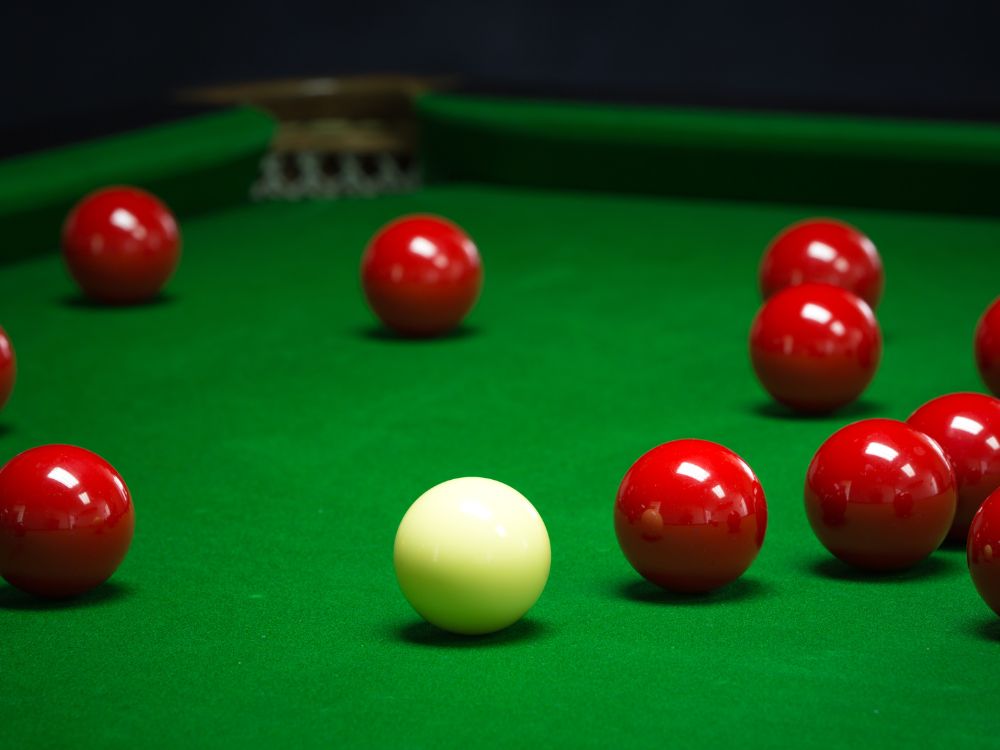In the game of snooker, a “kick” refers to an unexpected deviation of a ball’s intended path, usually resulting from a brief stickiness between the cue ball and the object ball upon contact. This phenomenon can have a significant effect on the game, potentially altering the trajectory of a well-planned shot.
Snooker is an intricate game of precision and strategy, a delicate ballet on a baize-covered table.
Each shot is a thoughtful blend of geometry and touch, meant to set up future plays while disrupting opponents’ plans.
But every so often, an unpredictable factor known as a “kick” comes into play, introducing a random element to this otherwise skill-dominated sport.
This effect, sometimes dreaded by players, is a fascinating part of snooker physics, worth understanding whether you’re a veteran player or an intrigued newcomer.
Let’s get started!

What Causes a Snooker Kick?
The exact cause of a snooker kick is the subject of much debate among players and enthusiasts.
Some attribute it to chalk dust or other minute debris between the balls at the point of contact, causing a brief stick-slip motion.
Others believe it’s the result of static electricity built up on the balls.
While the exact mechanism remains disputed, it’s universally agreed that when a kick occurs, the cue ball doesn’t cleanly “push” the object ball, but rather “clings” to it briefly, leading to unexpected behavior.
Impact of a Kick
When a kick occurs, the cue ball or object ball may suddenly slow down, deviate from its intended path, or in extreme cases, even jump slightly.
This unpredictability is what makes kicks so frustrating for players, especially in high-stakes games.
A well-planned shot can be ruined by a kick, turning the tide of the game.
Preventing Kicks
While it’s impossible to eliminate the risk of kicks entirely, there are a few measures players can take to minimize their frequency.
Cleaning the balls frequently, ensuring that the cue tip is chalked properly, and maintaining optimal humidity and temperature conditions on and around the table can help.
Techniques to Minimize Kicks
While kicks in snooker can be unpredictable, certain techniques and practices can help to reduce their occurrence and mitigate their impact on your game.
- Proper Chalking: A properly chalked cue tip reduces the chance of slipping, which can lead to kicks. It’s recommended to apply chalk before every shot, covering the entire surface of the tip without caking it on.
- Clean Equipment: Ensure the balls and the table are clean. Any debris, like dust or chalk, can cause friction between the cue ball and the object ball, leading to a kick. Professional cleaning solutions and cloths are available for maintaining snooker equipment.
- Ideal Playing Conditions: Humidity and temperature can impact the play, and consequently, the occurrence of kicks. If possible, try to maintain a steady, moderate temperature and humidity level in your playing environment.
- Strike the Ball Correctly: Poor striking of the cue ball can sometimes cause kicks. Try to hit the cue ball as close to the center as possible when not imparting spin.
- Use of Anti-Kick Solutions: Some players swear by anti-kick solutions, which are applied to the balls to reduce static and cling. However, the use of these may depend on the rules of the venue or competition.
These techniques require practice and consistency but can go a long way in reducing the impact of kicks on your game.
Is a Kick Always Bad?
Ironically, even though a kick is generally seen as a nuisance, it can sometimes work in the player’s favor.
If a player has taken a risky shot and the balls are heading for an undesirable location, a kick can send them off in a different direction, potentially resulting in a more advantageous position.
Kick and the Rules of Snooker
According to the official rules of snooker, if a player feels that a shot was affected by a kick, they can request the referee to clean the balls.
However, no re-shot or other form of compensation is granted in these situations.
A kick is treated as part of the unpredictable nature of the game, akin to a gust of wind in outdoor sports.
Can you predict when a kick is going to occur?
No, a kick in snooker is typically unpredictable.
While there are theories about its causes—such as chalk dust or static electricity—its exact timing during a game can’t be predicted.
What should I do if I frequently experience kicks during play?
If you’re experiencing frequent kicks, it may be worthwhile to assess your equipment and playing conditions.
Regular cleaning of the balls and the table, maintaining optimal temperature and humidity, and ensuring your cue tip is well chalked can help.
In some cases, frequent kicks may be indicative of poor striking of the cue ball, which can be improved with practice and proper technique.
Do professional players experience kicks?
Yes, even professional snooker players experience kicks.
It’s an inherent part of the game, much like unpredictable wind conditions in outdoor sports.
Many professionals have their own techniques for minimizing kicks and coping with them during important matches.
In conclusion, a “kick” in snooker is a fascinating, albeit frustrating, phenomenon that adds an element of unpredictability to this game of skill and precision.
While its exact cause remains debatable, understanding it and adopting strategies to minimize its occurrence can improve a player’s game.
Even though it can sometimes alter the outcome of a match, it remains an integral and captivating part of the rich tapestry that makes up the game of snooker.